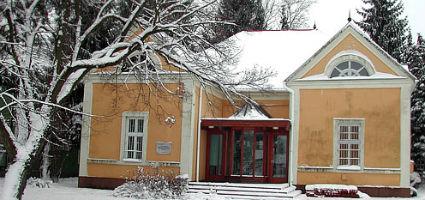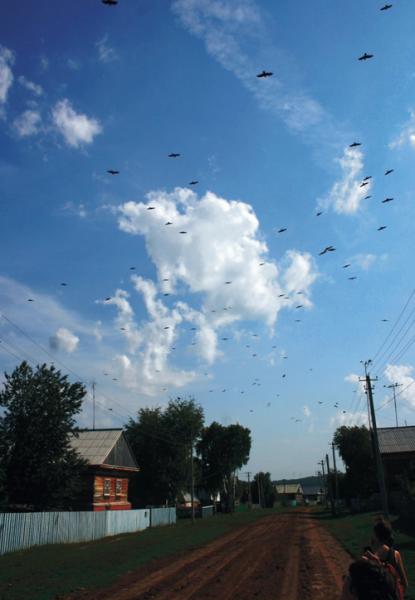2024. May 8. Wednesday
Town Museum - Nagyatád
 |
Address: 7500, Nagyatád Széchenyi tér 2.
Phone number: (82) 352-028
E-mail: hagyongy@gmail.com
Opening hours: 01.04-31.10.: Mon-Fri 9-12, 13-17, Sat 14-17
01.11-31.03.: Mon-Fri 9-12, 13-16 |
The exhibition has closed for visitors.
2008.11.29. - 2009.02.28.
Two flowers: two symbols. The symbol of the Bashkortostan nation is the flower kurai: seven petals symbolise the seven minorities living together. The Udmurt people’s symbol is the italmas. The photo exhibition of Dobó Attila, Mácsai Boglárka, Nagy Zoltán and Szamonek Vera is about them, the villages of the Udmurt people living in North Bashkortostan, their life, religion, everydays and everything that the photographers saw.

The photos organized thematically imitate an imaginary habitat where mostly Udmurts and some Tatar live. Three spatial units and three concentric circles help us envision the life of the villages.
"In the Suburbs": the first, the outmost circle represent the surroundings, the ploughlands and pastures, as well as the cemeteries and sacred places among them. The pictures show the life of Udmurt people towards the end of summer, their sacred places. Hidden interpretations of the relations of religion and ethnic identity are revealed. The visitors can see motifs on graves, signs of the Udmurt tradition of offering food and drink to the deceased.
"In the Village": The second space show streets in a habitat. Streets are the scenes of social life and various forms of life where the Bashkort state sphere is spectacularly present by way of tablets with economic data, wartime memorials, schools and libraries. Streets are also the places where ethnographers can make friendship and set up conversations. Subtle affiliations of the villagers open up in front of the eye.
"In the House": The third, innermost circle represents the family and institutional socializations. Entering the houses, the visitors can experience the connection of the owner with the colourful wood and brick houses. The family photos unfold individual and family lives. There are photos of the local history museum in the school with the mandatory threefold articulation with various readings of the past. The ethno-history of Udmurts is represented via a room interior. The institutional past of the school is shown in pageants, certain segments of the Russian-Soviet national history is denoted at the Military Memorial Exhibition. The structure of school museums offer the ethnic identity, Bashkortostan and Russian entwining existence, state constructed interpretation.
The concentric circles are like the rings of this multi identity. They can be very well noticed though the boundaries are not really distinct. Besides, the "Suburbs", the "Village" and the "House" do not only represent strata of Udmurts living in Bashkortostan but the ethnographers’ understanding process, stages of learning about the culture.
Bashkortostan (old Bashkir) is a region in the Russian Federation. According to the 1989 census, the population was 49 percent Tatar, 43 percent Russian, 4 percent Chuvash, 1 percent Ukrainian, and 1 percent Mordovian in the north, Tatars speaking Turkish and Udmurts speaking Finno-Ugric live. The population of Bashkortostan is 4.104.336 of which 990.702 are Tatar and only 22.625 are Udmurt.

The photos organized thematically imitate an imaginary habitat where mostly Udmurts and some Tatar live. Three spatial units and three concentric circles help us envision the life of the villages.
"In the Suburbs": the first, the outmost circle represent the surroundings, the ploughlands and pastures, as well as the cemeteries and sacred places among them. The pictures show the life of Udmurt people towards the end of summer, their sacred places. Hidden interpretations of the relations of religion and ethnic identity are revealed. The visitors can see motifs on graves, signs of the Udmurt tradition of offering food and drink to the deceased.
"In the Village": The second space show streets in a habitat. Streets are the scenes of social life and various forms of life where the Bashkort state sphere is spectacularly present by way of tablets with economic data, wartime memorials, schools and libraries. Streets are also the places where ethnographers can make friendship and set up conversations. Subtle affiliations of the villagers open up in front of the eye.
"In the House": The third, innermost circle represents the family and institutional socializations. Entering the houses, the visitors can experience the connection of the owner with the colourful wood and brick houses. The family photos unfold individual and family lives. There are photos of the local history museum in the school with the mandatory threefold articulation with various readings of the past. The ethno-history of Udmurts is represented via a room interior. The institutional past of the school is shown in pageants, certain segments of the Russian-Soviet national history is denoted at the Military Memorial Exhibition. The structure of school museums offer the ethnic identity, Bashkortostan and Russian entwining existence, state constructed interpretation.
The concentric circles are like the rings of this multi identity. They can be very well noticed though the boundaries are not really distinct. Besides, the "Suburbs", the "Village" and the "House" do not only represent strata of Udmurts living in Bashkortostan but the ethnographers’ understanding process, stages of learning about the culture.
Bashkortostan (old Bashkir) is a region in the Russian Federation. According to the 1989 census, the population was 49 percent Tatar, 43 percent Russian, 4 percent Chuvash, 1 percent Ukrainian, and 1 percent Mordovian in the north, Tatars speaking Turkish and Udmurts speaking Finno-Ugric live. The population of Bashkortostan is 4.104.336 of which 990.702 are Tatar and only 22.625 are Udmurt.
